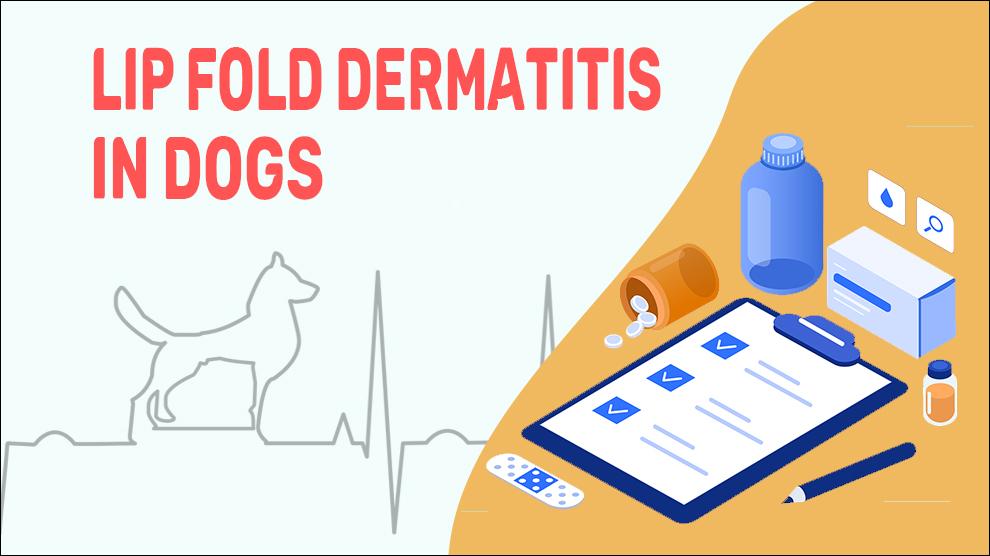What Is Lip Fold Dermatitis In Dogs?
Lip fold dermatitis (lip fold pyoderma) is a form of skin fold dermatitis (Intertrigo) in dogs, whose conformation allows for infection-prone folds in the skin. These are most common in breeds with unusual conformations pronounced in facial, vulvar, and tail folds; however, they can arise in any deep skin fold anywhere in the dog’s body.
Derma in Greek means “skin” and “-itis” means inflammatory condition. When the folds created by the dog's sagging lips trap moisture and debris (such as food particles) continuously, they will be unusually moist and may appear irritated and inflamed. The fold may be stinky and smell awful. Severe lip fold dermatitis in dogs breaks the skin, ulcers may form and infection can occur. Bacterial and Yeast infections are more common in dog skin folds.
Skinfold dermatitis is a dermatologic condition that leads to a skin infection, called pyoderma. Historically, both skin fold dermatitis and skin fold pyoderma are classified as a type of superficial pyoderma. Currently, they are categorized as a type of ‘surface pyoderma’ together with pyotraumatic dermatitis (“hot spots”).
Skinfold Dermatitis can occur in other parts of a dog’s body including the face, neck, vulva, and tail folds. Some breeds that have larger, saggier, floppier lips are more prone to lip fold dermatitis.
Symptoms Of Lip Fold Dermatitis In Dogs
- Redness, irritation, or an inflamed area in the lip fold.
- The malodorous odor of the lips or lip fold.
- Hair discoloration around the mouth.
- Rubbing, scratching, or Pawing at the mouth or face.
- Painful and agitated when lips or mouth touched or cleaned.
- Hairless (alopecic).
Treatment Options For Lip Fold Dermatitis In Dogs
Lip fold dermatitis treatment is multifactorial.
Antibiotics: Amoxicillin, polymyxin, cephalexin, fusidic acid, or silver sulfadiazine are frequently used together with steroids (prednisone, methylprednisolone, or dexamethasone).
Antifungals: Clotrimazole, topical nystatin, ketoconazole, econazole or oxiconazole.
Over-the-counter products include hydrocortisone cream, ketoconazole shampoo, and chlorhexidine gluconate.
Home Remedies For Lip Fold Dermatitis In Dogs
- Regularly wipe the skin around your dog’s mouth.
- Use pet-friendly antimicrobial wipes.
- Keep the mouth area clean and dry.
- Clean food and water bowl daily.
- Use ointments/Creams to ease itching & irritation.
- Use Cold compresses when needed.
- For chewy or scratchy dogs, Consider using an inflatable/ Elizabethan collar.
How To Prevent Lip Fold Dermatitis In Dogs?
Prevent this foul/musty condition by keeping your dog’s lip folds dry and clean.
Keep the lip folds/jowls/mouth clean which is usually twice a day. Use medicated wipes containing a skin disinfectant.
Don’t forget to dry the area thoroughly after cleaning.
Use clean paper towels (or a clean washcloth) and medicated dog shampoo (e.g. Nolvasan medicated shampoo).
Check with your veterinarian for medicated shampoo/ointments to clean the mouth area.
If you bathe your dog less often, you’ll have to spot clean the area daily to get rid of trapped food and moisture.
Affected Dog Breeds Of Lip Fold Dermatitis
Greyhound, Maltese, Miniature Schnauzer, Labrador Retriever, English Bulldog, Basset Hound, Bloodhound, Cocker Spaniel, Springer Spaniel, Pug, Pekingese, Shar Pei, Saint Bernard, Shih Tzu
Additional Facts For Lip Fold Dermatitis In Dogs
Causes:
Infection: The most common organisms found in cytology specimens of lip fold dermatitis suggest a mixed population of organisms.
Coccoid bacteria, bacilli, and yeast, including Streptococcus, Staphylococcus, Malassezia, and Pseudomonas species.
Other potential underlying causes are allergic skin diseases, skin-on-skin friction (intertrigo), and hormonal influences.
Morbidity:
The pathogenesis of lip fold dermatitis irritation and decreased air circulation and irritation, resulting in a damp, warm environment promotes localized microbiome proliferation.
These microbes in turn produce toxins and cause maceration of the skin making it itchy, red, and painful. Microbial penetration is enhanced into deeper skin compartments (epidermal/dermal) and causes ongoing inflammation and infection.
Mortality:
There is no documented mortality due to this condition.
Diagnosis:
- Cytology tests
- Patch tests
- Culture tests
Prognosis:
The prognosis for lip fold dermatitis is really good. As the existing condition is not life-threatening, no rigorous treatment is usually necessary. However, relapse is possible following medical treatment in affected dogs. Proper hygiene and home care are the best defenses against future recurrences.
When To See A Vet For Lip Fold Dermatitis In Dogs?
If the lip area looks inflamed and/or contains pus, smells stinky, or your dog gets agitated when you try to check the area, it’s better to set up an appointment with your veterinarian.
Food Suggestions For Lip Fold Dermatitis In Dogs
A well-balanced diet is a precautionary measure for this condition.
- Avoid providing meals that might have fats.
- Omega3 fatty acids- Mackerel, Salmon, Herring, Sardines.
- Lean meats, such as chicken breast, sirloin, or pork.
- Leafy green vegetables, cauliflower, and broccoli.
- Low fat, high protein foods- White-Fleshed Fish, Skinless, White-Meat Poultry, Beans, Peas, and Lentils.
Conclusion
Lip fold dermatitis prognosis is good with treatment. The recovery time for dermatitis is different for every dog. You’ll get a good idea of when to expect improvements depending on the treatment plan or antibiotic schedule prescribed by your vet.

















